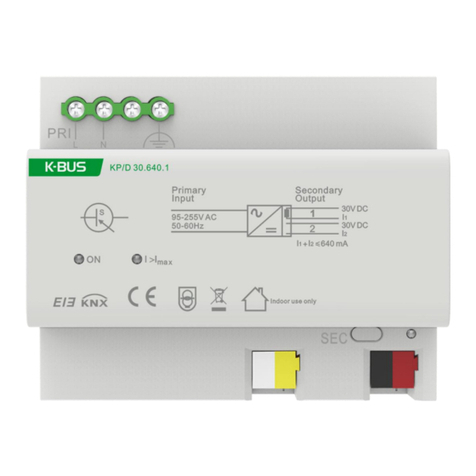
Contents
Chapter 1 Summary -----------------------------------------------------------------------------------------------------1
1.1 Function overview ----------------------------------------------------------------------------------------------- 2
1.2 Tunneling --------------------------------------------------------------------------------------------------------- 3
1.3 Routing ------------------------------------------------------------------------------------------------------------3
1.4 KNX IP Routers ---------------------------------------------------------------------------------------------------3
Chapter 2 Technical Data & Dimension and Connection Diagram ------------------------------------------------- 4
2.1 Technical data ----------------------------------------------------------------------------------------------------4
2.2 Dimension diagram ---------------------------------------------------------------------------------------------- 6
2.3 Connection diagram --------------------------------------------------------------------------------------------- 6
Chapter 3 Planning and Application -----------------------------------------------------------------------------------8
3.1 Operation Modes -------------------------------------------------------------------------------------------------8
3.1.1 LED indication -----------------------------------------------------------------------------------------------8
3.1.2 The Function Button ----------------------------------------------------------------------------------------8
3.1.3 The Programming Button and LED ------------------------------------------------------------------------9
3.2 IP router application --------------------------------------------------------------------------------------------- 9
3.2.1 KNX Telegrams in the IP Network -----------------------------------------------------------------------10
3.2.2 The IP Router in a Network Installation -----------------------------------------------------------------11
3.2.3 The IP Router as an Area Coupler ----------------------------------------------------------------------- 11
3.2.4 The IP Router in a Mixed System ------------------------------------------------------------------------11
3.2.5 The IP Router as A Line Coupler -------------------------------------------------------------------------13
Chapter 4 Parameter setting description in the ETS ---------------------------------------------------------------14
4.1 Physical Address Assignment -------------------------------------------------------------------------------- 14
4.2 General ---------------------------------------------------------------------------------------------------------- 15
4.3 IP Configuration ------------------------------------------------------------------------------------------------ 16
4.4 KNX Multicasting Address ------------------------------------------------------------------------------------ 17
4.5 Main Line -------------------------------------------------------------------------------------------------------- 18
4.6 Sub Line --------------------------------------------------------------------------------------------------------- 19
Chapter 5 Web Front-end --------------------------------------------------------------------------------------------- 22
5.1 Accessing the Web Front-end ---------------------------------------------------------------------------------22
5.1.1 Via windows Network UPnP ------------------------------------------------------------------------------23
5.1.2 Via IP Address ---------------------------------------------------------------------------------------------24
5.1.3 Via MAC Address ------------------------------------------------------------------------------------------25
5.2 Device Info ------------------------------------------------------------------------------------------------------ 26
5.3 KNX -------------------------------------------------------------------------------------------------------------- 27
5.4 Firmware Update / Boot Mode -------------------------------------------------------------------------------- 28
5.5 IP Tunneling Address Assignment --------------------------------------------------------------------------- 30
Chapter 6 State of Delivery ------------------------------------------------------------------------------------------- 32




























